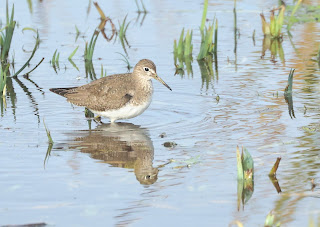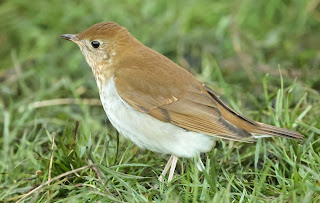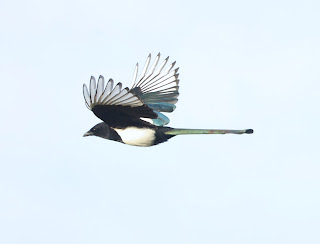Veery: Autumn migration in Shetland is one of the ornithological highlights of the birding calendar! And part of the year I have really been looking forward to for some time. This would be my 4th year on the run top here and I had big hopes for finding rare birds and ticking a few new ones.
This year, six top birders and friends booked the trip with me. A group which included Patrick Earth, Gary Edwards, Damian Young, Kristian Wade and Rob Black. A top bunch of lads and top birders, great to spend a week away birding them all.
Rob and Patrick headed up a day earlier then the rest of us opting to fly, so they connected with this American mega while we were travelling up via car and ferry! Bring a day behind and knowing we may miss out on what could be the b best bird of the trip was giving me some serve anxiety!
Patrick and rob were sending us some crippling pictures too which wasn't help, Guess I would have done the same if the situations were revered, nothing like a bit of banter. Luckily the veery did the decent thing and stayed, it was favouring the same line of sycamore trees we had a barred warbler in the years previous.
The veery is a medium-sized member of the thrush family with a plump body, long wings and legs, a small head, and a straight, narrow bill.
It has cinnamon brown upperparts and pale underparts, grey flanks, and indistinct spots on the cream-coloured breast.
They get their name “Veery” from the song that males use to defend territory. A series of variations on veer, the song descends slightly in pitch, and resonates as if whirling around inside a metal pipe.
The veery showed astonishingly well and hopped out on the damp muddy field in-front of the sycamores right infant of me. The bird actually reminded in the area right upon I rill the end of the week before disappearing at the weekend.
Yellow-browed Warbler: This year we stayed in Scalloway at Easterhoull chalets's self-catering accommodation which was split into three people per chalets. They got a mixed reception from the guys but I liked then, they were warm, clean and really central to Lerwick and some good birding locations.
Olive-backed Pipit: This was one of the highlights of the trip, I don't think I will ever see an OPB, a bird which is famous for being skulky and elusive as well as this bird.
This bird was right out in the open, walking and foraging on the ground among the grass and close to the cover. It wasn't shy in coming right out in the open, a brilliant experience and like I said, a high light of the trip.
A fairly characteristic pipit due to the fresh plumage tones, defined facial pattern and marked breast streaking. Back olive-coloured with only faint streaking. Rump lacks streaking. Usually shows a pale and a black spot on rear cheeks. Legs pinkish, with short hind-claw, similar to Tree Pipit. Similar behaviour as Tree Pipit.

Just like tree pipits they readily enter trees, and will also walk along branches. This bird was regal;y seen hopping and fluttering up on to perched in trees.
The bird took up residence at Voxter House & Walled Garden close to Brae, a grade A listed building and random rubble wall enclosing rectangular garden to south west of the main building.
Coming back to our accommodation one evening from here Birdguides tweeted a rare bird, a local rare bird and one of my top most wanted birds, a snowy owl!
Snowy Owl: After getting some gen and figuring out what we need to do we arrived at the top of Ronas Hill and began the long, steep and tiresome hike upwards, towards the bird.
it would be tough going as the terrain consist of bare, stony tundra; slightly boggy initially. No paths and few landmarks so good navigation.
Ronas Hill is the highest summit in Shetland, rising as a broad dome of stony, granite tundra above the great plateau of North Roe. This is a wild and windswept place but the views are superb, and the track up to the masts on Collafirth Hill makes for a high level start.
I was the first to arrive at the summit followed swiftly by Kristian and Patrick while the others were huffing and puffing their way through the bogs and over the stony slopes to the plateau.
We then found the group of birders who made an earlier start then us and were watching the bird from a very safe and respectful distance to the bird.
It was hunkered sown out of the wind and rain, sandwiched between two late boulders before flying father uo to and more shuttled area of the slopes.
They live primarily in the Arctic polar region, but can be seen as a migratory visitor to northern Britain. But I have here'd that this is a resident bird to Shetland. The Snowy Owl hunts by quartering over open land, searching for small mammals, insects and birds.
Snow Bunting: Another snowy bird that's more at home in the arctic from Scandinavia to Alaska, Canada and Greenland and migrate south in winter.
But an annual visitor to the UK during winter they were found all over Shetland, from Ronas Hill to the costal areas towards the south of the island.
Snow bunting are always great to catch up with, pretty little bird that don't mind being photographed while Pershing on shoreline stones and rocks, it was good to add them to the trip list.
We did have a few rainy, windy days were out birding was either inturupted or cancelled all together. Like in Shetland I guess, where the weather if fine somedays throughout the year, but the weather can change quickly in a day and you can experiance all season in a day.
Yellow-browed Warbler: As the week progressed we connected with more YBW's, hearing their distinctive call from sycamores and willows across the island.
Yellow-browed is the icing on the migratory cake. Where these little noisy warblers are, other great birds will be nearby. YBW's are a fixture in many a happy memory; of bushes humming with hungry birds, berries red and leaves reddening, the camaraderie of fellow delighted birders, the last autumn sunshine and the first storms.
White's Thrush: Another bird that broke during the late afternoon was this White's thrush, a rare Shetland Autumn speciality, considered one of the the "Shetland Big Five".
We got the first ferry across and were joined by most of the riders on Shetland and after a short tense wait the bird was seen well in flight. Kristian and I went back on one of the slower days and got some better views of it on the deck. Well worth the muddy knees and elbows as he hunched down to see the bird under the woodland canopy.
The largest thrush of west Palearctic, as big or at least as long as mistle thrush but heavier about bill, head, and body and proportionately shorter-tailed. Structure unusual: bill long and heavy, head large, and wings relatively long (though bluntly pointed) in comparison with tail; combined with undulating flight, gives woodpecker-like appearance.
White's thrush are simply stunning birds, with golden- olive-buff above and yellow-white below, copiously scaled with black crescents on head and body and softly banded dark across primaries and primary coverts and along ends of all flight feathers. Underwing striped white, black, white, and grey from front to rear.
In recent years the track record of Shetland is unrivalled, compared to Scilly, or the Western Isles the Northern Isles have run away with the show. Rare Siberian have always been our big thing in the past and perhaps maybe now more than ever, but this year has been all about the New World megas!
Blyth's Reed Warbler: Another example of the Eastern birds we had was this Blyth's reed, a tricky bird to ID but with a call that can seperate it. the bird was agin, typically shy it took a while before it showed well.
Yellow-browed Warbler: A river warbler was found on our second day but it took us several days to actually connect with it, typically elusive and in an area which was closed down in the afternoon due to its location to a school.
When we did catch up with the river warbler the heavens opened, it was by far the west day we had for rain, we were all drenched, Garys wellies never recovered and some mositure got into my camera, thankfully only temporally.
My views were pretty poor, especailly compared to the Ham Wall bird I saw. Some folk in the same crowed didn't connect with it at all, disappointed for them the bird remained for a few days so hopefully they had another chance at it.
Barred Warbler: One of the areas we favoured was Hoswick, a settlement in Sandwick in the south mainland of Shetland, Scotland, on the eastern part of the Dunrossness civil parish. It is separated from the rest of Sandwick by the Hoswick Burn and from Channerwick in the south by the hill on which the settlement is situated.
It was here we had good views of YBW's, barred warbler and RBF's, we spent ages here repeated walking down the streets and pi king birds up in the bushes, garden and roadside vegetation.
As I write this blog post, sitting at home there has been an American yellow warble found here in Hoswick. Typically.
Next year I will be looking for one, keeping my eyes open and hoping to struck, gold....no....strike yellow!
Red-breasted Flycatcher: I was lucky enough to find a RBF on a day when none where picked up, a bird hiding from the wind, taking shelter in a small garden.
There's always a branch in the way!
I managed to get the gang on t and eventually more birders saw it before it was cashed off by a robin and relocated in a sycamore tree a few streets over.
Stejneger's Stonechat: This recent split of the former Common Stonechat S
axicola torquata into several species (including European Stonechat
Saxicola rubicola, Siberian Stonechat and now Stejneger’s Stonechat) are becoming more common.
Breeding in in central and eastern Siberia, Japan, Korea, northeastern China, and eastern Mongolia, and migrates south to southern China and Indochina in winter they are a typical eastern bird that can turn up on Shetland during Autumn.
Magpie: Shetland famed for its for its large falls of Autumn migrants and perhaps not for magpies, this one we saw on Bressay the same day as the White's thrush was the first record for Bessay. These birds in a way are more rare on Shetland than the mega Whites's thrush!
Bluethroat: This long staying bluethroat was happily at home on a large dung pile, feeding and hiding in the tall vegetation in the middle of a sheep pen.
The bluethroat is a small passerine bird that was formerly classed as a member of the thrush family
Turdidae, but is now more generally considered to be an Old World flycatcher,
Muscicapidae. It, and similar small European species, are often called chats.
It is a migratory insectivorous species breeding in wet birch wood or bushy swamp in Europe and across the Palearctic with a foothold in western Alaska. It nests in tussocks or low in dense bushes. It winters in the Iberian Peninsular, the northern half of Africa, and in southern Asia (among others including the Indian subcontinent).
Eastern Sub-alpine Warbler: Another new bird for me was this eastern race of sub-alp warbler, took a while to see in poor conditions but it eventually gave up hiding and showed well along a fence line near the garden we were watching.
Short-toed Lark: Sometimes known as the greater short-toed lark is a small passerine bird. It breeds in southern Europe, north-west Africa, and across temperate Asia from Turkey and southern Russia to Mongolia. This is a small pale lark, smaller than the skylark.
We had such a good time, finding our own birds and chasing others, I had 4 new lifers including, the veery, White's thrush, Eastern Sub-alpine warbler and the snow owl.
Marsh Warbler: And as a group we ticked 104 birds for the trip. We drank and ate our way through Lerwick and covered a ton of miles.
Loved every minute of it, cheers lads. Here's to next year.













































































